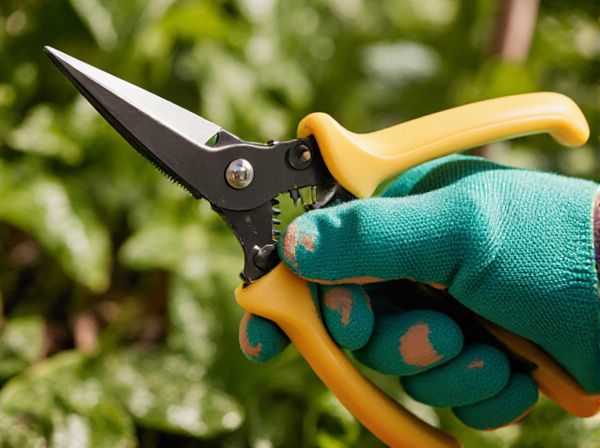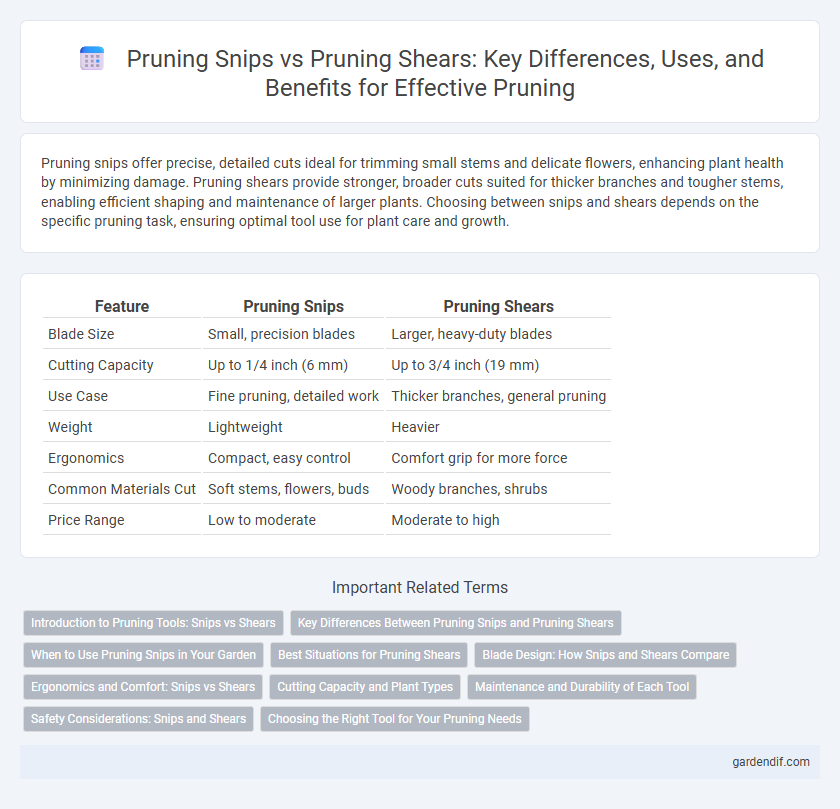
Pruning snips vs Pruning shears Illustration
Pruning snips offer precise, detailed cuts ideal for trimming small stems and delicate flowers, enhancing plant health by minimizing damage. Pruning shears provide stronger, broader cuts suited for thicker branches and tougher stems, enabling efficient shaping and maintenance of larger plants. Choosing between snips and shears depends on the specific pruning task, ensuring optimal tool use for plant care and growth.
Table of Comparison
| Feature | Pruning Snips | Pruning Shears |
|---|---|---|
| Blade Size | Small, precision blades | Larger, heavy-duty blades |
| Cutting Capacity | Up to 1/4 inch (6 mm) | Up to 3/4 inch (19 mm) |
| Use Case | Fine pruning, detailed work | Thicker branches, general pruning |
| Weight | Lightweight | Heavier |
| Ergonomics | Compact, easy control | Comfort grip for more force |
| Common Materials Cut | Soft stems, flowers, buds | Woody branches, shrubs |
| Price Range | Low to moderate | Moderate to high |
Introduction to Pruning Tools: Snips vs Shears
Pruning snips are precision tools designed for delicate tasks such as trimming small stems, buds, and flowers, enabling clean cuts without damaging the plant tissue. Pruning shears, also known as secateurs, are robust hand-held clippers suited for cutting thicker branches and woody stems up to about 3/4 inch in diameter, providing leverage for tougher pruning jobs. Both tools are essential for effective garden maintenance, with snips offering fine control and shears delivering power for heavier pruning tasks.
Key Differences Between Pruning Snips and Pruning Shears
Pruning snips are small, lightweight tools designed for precision cutting of delicate stems and flowers, typically under half an inch in diameter, while pruning shears, also known as secateurs, are larger and built for cutting thicker branches up to one inch thick. Pruning snips offer fine control and are ideal for detailed garden tasks, whereas pruning shears provide greater leverage and cutting power for more robust plant material. The ergonomic design of shears supports extended use in heavier pruning applications, distinguishing them from the more delicate, scissor-like snips.
When to Use Pruning Snips in Your Garden
Pruning snips are ideal for delicate tasks such as trimming small flowers, herbs, and thin stems less than 1/4 inch in diameter, ensuring precision without damaging surrounding plants. Their sharp, fine blades allow gardeners to perform detailed cuts necessary for shaping and maintaining the health of young plants and bonsai trees. Using pruning snips helps promote quicker healing and reduces the risk of disease compared to larger tools like pruning shears.
Best Situations for Pruning Shears
Pruning shears are ideal for cutting thicker branches and woody stems up to 3/4 inch in diameter, providing precise control and clean cuts that promote healthy plant growth. They excel in garden maintenance tasks such as shaping shrubs, trimming rose bushes, and removing dead or diseased stems. Their ergonomic design reduces hand fatigue during extended pruning sessions, making them the best choice for heavy-duty pruning jobs compared to pruning snips, which are better suited for delicate tasks like deadheading flowers and trimming small, tender stems.
Blade Design: How Snips and Shears Compare
Pruning snips typically feature short, sharp blades designed for precision cutting on small stems and delicate plants, enabling accuracy and control in tight spaces. Pruning shears have longer, curved blades optimized for cutting through thicker branches and woody stems, providing leverage and power for tougher pruning tasks. The blade design differences directly impact their suitability for specific gardening activities, with snips excelling in detailed trimming and shears in more robust pruning jobs.
Ergonomics and Comfort: Snips vs Shears
Pruning snips offer precision cutting with lightweight handles that reduce hand fatigue, making them ideal for detailed tasks in tight spaces. Pruning shears typically feature cushioned grips and ergonomic designs that distribute pressure evenly, enhancing comfort during extended use on thicker branches. Choosing between snips and shears depends largely on the balance of control versus leverage needed for the specific pruning job.
Cutting Capacity and Plant Types
Pruning snips offer precise cuts ideal for small stems up to 1/4 inch in diameter, making them suitable for delicate flowers, herbs, and young shoots. Pruning shears handle thicker branches ranging from 3/8 to 3/4 inch, perfect for shaping shrubs, roses, and woody perennials. Choosing the right tool depends on the plant type and stem thickness to ensure clean cuts that promote healthy growth.
Maintenance and Durability of Each Tool
Pruning shears typically feature robust, replaceable blades that maintain sharpness longer and require occasional sharpening, whereas pruning snips often have smaller, less durable blades suitable for light trimming but may dull more quickly. Maintenance of pruning shears involves regular cleaning, oiling pivot points, and blade replacement to ensure optimal performance and longevity. Pruning snips demand less intensive upkeep but generally offer lower durability, making them better suited for occasional or delicate pruning tasks.
Safety Considerations: Snips and Shears
Pruning snips offer precise cutting for smaller branches, reducing the risk of slips and injuries with their lightweight design and ergonomic handles. Pruning shears, designed for thicker branches, require more force and careful handling to prevent strain or accidental cuts, making safety gloves essential during use. Both tools demand regular maintenance and proper technique to ensure safe operation and prolong tool life.
Choosing the Right Tool for Your Pruning Needs
Pruning snips deliver precision cutting ideal for delicate tasks such as trimming flowers and small stems, with sharp, fine blades designed for detailed work. Pruning shears are better suited for cutting thicker branches up to 3/4 inch in diameter, featuring serrated blades and ergonomic handles for more leverage and control. Selecting the right tool depends on branch thickness and plant type to ensure clean cuts and promote healthy growth.
Pruning snips vs Pruning shears Infographic

 gardendif.com
gardendif.com